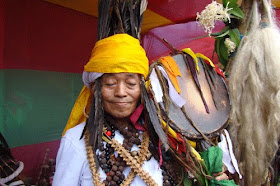Mangpas Bijuwa/Nakhong Rai Shamans
The culture of Rais is based on the tradition of their own Kirat religion. The child is named four days after birth, following which the Rai priest (Bijuwa or Ngopa) lifts the head of the mother and child after performing special ceremonies and gives a name to the child (Toba, 1992:19). During the initiation ceremony, the rope used for tethering cows is used. Love marriage with agreement between both partners is common. Whatever the type of marriage, however, those from the boy’s side have to go with alcohol and gifts (sagun) to the girl’s house and ask for their consent and offer apologies. The Rais do not marry their maternal uncle’s and aunt’s daughters, though there is a practice of marrying one’s windowed elder sister-in-law.
The dead are buried, although some also cremate the dead or leave the body in a river to flow with the current. These customs vary among the different subgroups of Rais. After abstaining from eating three meals and from eating salt and oil for five meals, the period of pollution is over. The Rais have much faith and trust in stones and grass, and when undertaking a vow for any reason, they take stone and grass in their hands. Although Rai are divided into many subgroups, they do not practise any discrimination on the basis of these groups and there are no rules of commonality while dining. Women are not discriminated against in Rai society.
The Rais follow the customs and traditions made by their elders and leaders. Their social strictures and rituals are open and liberal. People from other ethnic groups have assimilated into the subgroup (Sharma, BS2052:110). The thar or subgroup and further smaller groupings (Pacha) within the subgroup number more than four dozens among Rais. Each pacha or grouping has its own beliefs and customs, and some do not partake of goat meat while others do. The Rais extensively use alcohol not only in religious activities but also in social activities. The Rais have the tradition of Parma or reciprocal labour system. The religion of Rai is Kirat religion. They worship Sumnima and Paruhang as the archetypal proto-female and proto-male respectively. The worship of ancestors is significant and occurs to a great extent among the Rais. As a form of land worship, Rais perform the Sakela Puja (Chandi Puja) in the months of Baisakh and Mangsir. The oven of Rais has three Chamka (stove), which symbolizes three gods. Ginger, home-brewed beer of millet, a pot (Chinda) for keeping beer and banana leaves are very important among the Rais. The religious text of Rai is Muddhum (Mundhum), which is in oral form.
Rai are mainly farmers; therefore, their main occupation is farming. Hunting is their profession from time past, and they like to use bow and arrows. In the past they used to weave their own clothes (Khandi) to wear. Nowadays, the Rais are also employed in foreign military service and in foreign.














Comments
Post a Comment